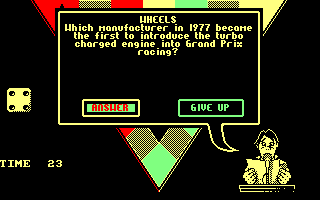
Sporting Triangles
(CDS, 1989)
This quiz game is based on ITV’s short-lived version of the TV quiz show A Question of Sport. Three players choose an area of sport, and then they take it in turns to move around a triangular board, answering questions based on the three subjects that have been chosen, as well as the occasional question on general sport. The game consists of seven rounds, but apart from the last round, which is a quick-fire session, there is only one question in each round. This makes each game rather short. Many of the questions are now outdated, and unless you have a really good knowledge of many sports, you won’t like this game. It does have a great rendition of the theme tune, though. (The answer to the question in the screenshot is “Renault”, by the way.)
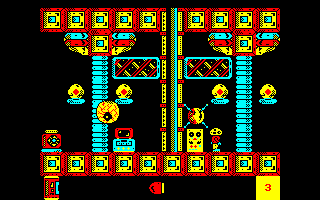
Sputnik
(SPE, 1986)
Robots have taken over the Earth, and the only hope for the human race is to send an SOS – but the robots have also shut down all the satellite communication systems. A remote-controlled android has been sent into the communications building to reactivate the Sputnik devices within it so an SOS can be transmitted. You control the android and you must explore the building and find and activate thirty Sputniks. Initially this game feels pleasant enough, although the graphics lack colour, but every time you lose a life, you’re sent right back to the starting room! As the building contains over 200 rooms, this is extremely annoying and frustrating.
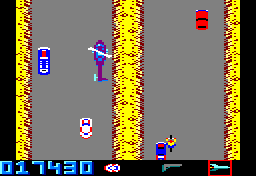
An arcade game licence tie-in of Bally Midway’s top-down, vertically scrolling driving shoot-’em-up. You play a super spy out to save your own life from a variety of other spies intent on doing you harm. Taking control of a fast red sports car which can transform into a speedboat is how you plan to stay alive. You have the option of playing at one of two skill levels – novice or expert. Just like the arcade version, you drive along a winding course with large amounts of enemy spies to blow up, either by bumping them off the road or blasting them with your firepower. A lorry also drives by regularly to upgrade your weaponry. Graphically it’s different to the arcade version but not in a negative way. The gameplay and control of your vehicle is more than agreeable and you’ll find yourself playing again and again to get a higher score.
![]() Watch YouTube videos of this game by:
ChinnyVision,
Xyphoe.
Watch YouTube videos of this game by:
ChinnyVision,
Xyphoe.
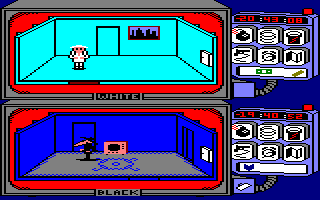
Spy vs Spy
(Beyond, 1985)
Two spies are in an embassy, and they have to collect four objects before making their escape in an aeroplane. The objects are all hidden underneath furniture and ornaments, so a lot of searching is needed – and you’ll need to find the briefcase first. The amusement really begins when you plant booby-traps to catch your enemy unawares, and steal the objects off him – but try to remember where you planted them, or you may be caught out! It’s got simple graphics and sound effects, but it is so addictive in the two-player option that you won’t be able to resist it.
See also: Spy vs Spy: Arctic Antics, Spy vs Spy: The Island Caper.
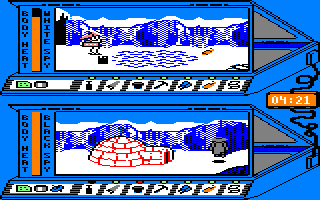
Spy vs Spy: Arctic Antics
(Databyte, 1987)
The third and final game in the Spy vs Spy series on the CPC sees White Spy and Black Spy compete with each other once again, this time to escape from an Arctic island on a rocket ship before a severe blizzard hits the island. To launch the rocket, each spy needs to find three objects and a briefcase in which to store them. Like the previous two games, this one features a variety of traps to catch out your opponent, but you also have to be careful not to freeze to death. If you enter the same area as your opponent, you can engage in a snowball fight. The graphics are all right, and thankfully there’s no annoying in-game music, but the one-player mode is too easy, even on the highest of the five difficulty levels, and laying traps and adding objects to your briefcase is annoyingly fiddly.
See also: Spy vs Spy, Spy vs Spy: The Island Caper.
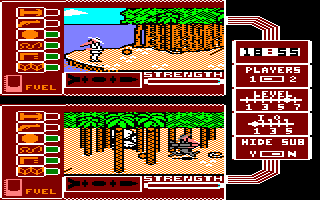
Spy vs Spy: The Island Caper
(Databyte, 1987)
Those two spies are at it again. This time they’re stranded on a desert island and have to find three pieces of a missile and return it to a submarine. The traps are more inventive this time, and they include napalm bombs and nooses, and there’s a gun lying somewhere too... Sadly, everything that made Spy vs Spy such enormous fun (especially with two players) has gone. The scrolling is excruciatingly slow, the music is terrible, the controls don’t respond well, and the traps are too difficult to place. I would stick with the first game in the series.
See also: Spy vs Spy, Spy vs Spy: Arctic Antics.
![]() Watch a YouTube video of this game by:
ChinnyVision.
Watch a YouTube video of this game by:
ChinnyVision.
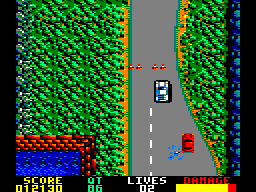
The Spy Who Loved Me
(Domark, 1991)
Both the British and the Russians have had some of their submarines stolen by Karl Stromberg. The British have sent out James Bond to recapture their sub, while the Russians have sent the attractive Anya Amasova. The last of the five James Bond games to be released for the CPC has five levels taking place on both land and sea, and all of them involve steering your car or boat and avoiding the scenery (you can try shooting the enemies, but it does little good). You have to collect tokens in the first three levels to buy the equipment to go to the next level. All the levels see you doing the same thing each time, and there’s very little variety.
See also: Licence to Kill, Live and Let Die, The Living Daylights, A View to a Kill: The Computer Game.
![]() Watch YouTube videos of this game by:
ChinnyVision,
Xyphoe.
Watch YouTube videos of this game by:
ChinnyVision,
Xyphoe.
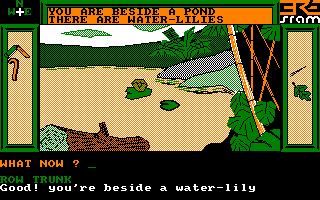
Sram
(Ere Informatique, 1986)
You have been transported to the mysterious planet of Sram, where the high priest Cinomeh has imprisoned the King Egres IV. (If you wonder where these strange names come from, they’re based on the names of the game’s authors.) You must free him – but first, you will need to find the hermit, and all the ingredients for a special potion that he will make for you. This text adventure comes from France and is regarded as a classic there, although you can also play the game in English or German. Certainly the graphics are fairly impressive, but I found the parser to be lacking in some areas, and finding the exact combination of words to perform particular actions is frustrating. I suppose it was good for its time, but nowadays it isn’t as good.
See also: Sram 2.
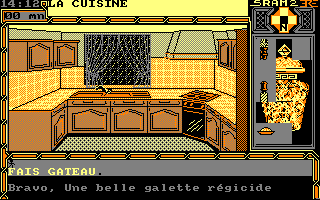
Sram 2
(Ere Informatique, 1986)
 Knowledge of French is required in order to play this game properly.
Knowledge of French is required in order to play this game properly.
Now that Egres IV is in power again, he repays your kindness by ruling through tyranny, oppressing his people and using sorcery. The only way to stop him is to kill him – but in a rather unusual way, by making what is known in France as ‘la galette des rois’, or ‘the kings’ cake’ – a cake with a bean hidden inside it. You start in a crypt, where the only ways out are to open the tombs contained within it. I wasn’t particularly satisfied with Sram, but this sequel is much better. The graphics are as good as, if not better than, the original game, and there are no problems finding the right combination of words to solve puzzles. On the other hand, it is slightly too easy, but that doesn’t worry me too much.
See also: Sram.
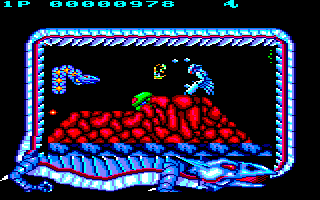
Similar to R-Type, here you control a baby dragon that has to rescue its mother. On the way you encounter weird metallic creatures such as mechanical tigers, cyborg bulls and armoured cobras who act as half- or end-of-level bosses. Power-ups can be picked up by shooting special pills that are littered around the scenery. Thankfully, unlike other similar games, when you die you don’t lose them, even after a new continue. Your dragon also has a unique feature; your tail is impervious – only its head is vulnerable. This proves very useful when you’re surrounded by enemies and their fire, as you can respectively destroy them and block with it. Nice looking, but a rather slow scrolling affair that is made difficult by the rather small screen area.
